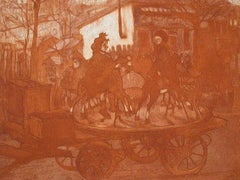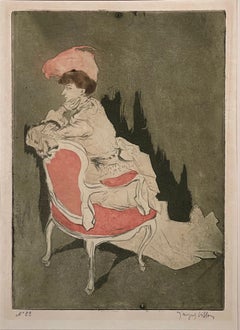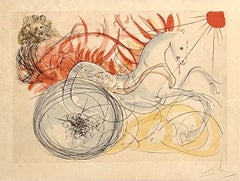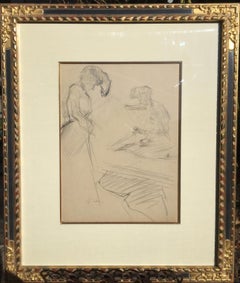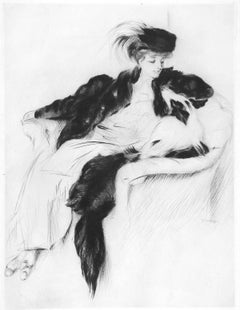Jacques Villon Art
French, 1875-1963
Jacques Villon was born Gaston Duchamp in 1875. He was the oldest brother of the artists Marcel Duchamp, Suzanne Duchamp-Crotti and the sculptor Raymond Duchamp-Villon. Initially a law student, in 1894 he went to Paris to study art. It was there that he met Henri Toulouse-Lautrec and other influential artists in Paris, and changed his name to Jacques Villon, after the poet. Villon made prints of some of the most well-known belle-époque portraits and genre scenes of the early twentieth century. Around 1911, he came under the influence of Picasso and other cubists, and became a leading exponent of the style, exhibiting in the 1913 Armory Show in New York. In 1922, the Galerie Bernheim-Jeune commissioned Villon to produce a series of color aquatints after 38 major nineteenth- and twentieth-century paintings. This series included works by Pierre Auguste Renoir, Henri Matisse, Pablo Picasso, Paul Cezanne, Georges Braque, Raoul Dufy, Amadeo Modigliani, Edouard Manet, Pierre Bonnard, and others. Artists who were alive at the time of the printing collaborated with Villon, and signed the prints. The project took ten years to complete. Several of these prints are valued highly today, and some went on to be reproduced by the Louvre Museum as photo-etchings. Villon's 'cubist' etchings, with their characteristic cross-hatching, are amongst the most renowned prints of the twentieth century. Jacques Villon's long career brought him fame. The diverse nature of his paintings, from end-of-the-century portraits to cubist and abstract styles to graphic works, made him a major figure in twentieth-century art. He was made a Grand Officer of the Légion d'Honneur, and upon his death in 1963, and he was given a state funeral.(Biography provided by Georgetown Frame Shoppe)
to
15
2
3
1
5
4
1
3
1
5
1
Overall Height
to
Overall Width
to
7
3
1
17
13
8
7
6
4
2
2
2
2
1
1
1
1
1
1
1
1
1
1
87
17
3
6
8
11
21
10
3
88
47
26
24
23
14
14
6
6
1
Period: Early 1900s
Artist: Jacques Villon
Manége Rue Caulaincourt ou Le Petit Manége Aux Chevaux de Bois
By Jacques Villon
Located in London, GB
JACQUES VILLON 1875-1963
(Gaston Duchamp) Damville 1875-1963 Paris (French)
Title: Manége Rue Caulaincourt ou Le Petit Manége Aux Chevaux de Bois, 1904
Technique: Original H...
Category
Early 1900s Jacques Villon Art
Materials
Aquatint, Etching
Young Girl with the Cats - Original handsigned etching - 30 copies
By Jacques Villon
Located in Paris, FR
Jacques VILLON
Young Girl with the Cats (Minne et les chats buvant), 1907
Original etching
Handsigned in pencil
Limited to 30 copies
On linen...
Category
Early 1900s Realist Jacques Villon Art
Materials
Etching, Aquatint
Vielle Femme en Petite Cape
By Jacques Villon
Located in Milwaukee, WI
Signed with stamp, J.V.
7-5/8" x 4-3/4" art
19" x 15-1/4" frame
Jacques Villon (French, 1875 - 1963) French painter, printmaker and illustrator. The oldest of three brothers who became major 20th-century artists, including Raymond Duchamp-Villon and Marcel Duchamp, he learnt engraving at the age of 16 from his maternal grandfather, Emile-Frédéric Nicolle (1830-94), a ship-broker who was also a much appreciated amateur artist. In January 1894, having completed his studies at the Lycée Corneille in Rouen, he was sent to study at the Faculty of Law of the University of Paris, but within a year he was devoting most of his time to art, already contributing lithographs to Parisian illustrated newspapers such as Assiette au beurre. At this time he chose his pseudonym: Jack (subsequently Jacques) in homage to Alphonse Daudet’s novel Jack (1876) and Villon in appreciation of the 15th-century French poet François Villon...
Category
Early 1900s Impressionist Jacques Villon Art
Materials
India Ink, Gouache
LE POTIN
By Jacques Villon
Located in Portland, ME
Villon, Jacques (French, 1875-1963) LE POTIN (GP E96) Drypoint and aquatint printed in green, 1904, Edition of 50. Printed on Arches paper, signed and numbered 32 in pencil. Publishe...
Category
Early 1900s Jacques Villon Art
Materials
Drypoint, Aquatint
Minne Playing with a Cat (Minne Jouant avec un Chat)
By Jacques Villon
Located in New York, NY
Jacques Villon (1875-1963) etching, aquatint, and drypoint, Minne Playing with a Cat (Minne Jouant avec un Chat),1907, signed in pencil and numbered (12/30)(Ginestet and Pouillon 192...
Category
Early 1900s Impressionist Jacques Villon Art
Materials
Drypoint, Etching, Aquatint
LA PARISIENNE
By Jacques Villon
Located in Portland, ME
Villon, Jacques (1875-1963). LA PARISIENNE (TOURNEE A GAUCHE, PETITE PLANCHE). G PE93. Etching and aquatint in colors, 1904. Edition of 100 Printed on cr...
Category
Early 1900s Jacques Villon Art
Materials
Etching, Aquatint
LES PETITS HALEURS
By Jacques Villon
Located in Portland, ME
Villon, Jacques. LES PETITS HALEURS. GP 176. Etching and Aquatint, 1907. Edition of 50 on Arches laid paper, signed and numbered in pencil, 5 3/4 x 7 3/4 inch...
Category
Early 1900s Jacques Villon Art
Materials
Etching, Aquatint
"Mes Petites Amies, Les Deux Sœurs" signed by Jacques Villon
By Jacques Villon
Located in Milwaukee, WI
This is an original drypoint and aquatint artwork by Jacques Villon. The artist signed in pencil on the lower right. As well as signed in plate at the top right of the image. This is a wonderful artwork of different intaglio processes being brought together in a beautiful almost seamless harmony. The thin pencil like markings and hair detailing are made using the Drypoint printmaking method. Whilst the color details around the girls are made using the Aquatint etching method. Jacques Villon shows his skills as a printmaker with the way these pieces line up perfectly and with how clean the rest of the plate is around the girls.
Catalogue Raisonne E101, pg. 66-67 (Ginestet & Pouillon. It depicts two young girls.
15" x 11 1/2" art
25 1/8" x 20" frame
French painter, printmaker and illustrator. The oldest of three brothers who became major 20th-century artists, including Raymond Duchamp-Villon and Marcel Duchamp, he learnt engraving at the age of 16 from his maternal grandfather, Emile-Frédéric Nicolle (1830-94), a ship-broker who was also a much appreciated amateur artist. In January 1894, having completed his studies at the Lycée Corneille in Rouen, he was sent to study at the Faculty of Law of the University of Paris, but within a year he was devoting most of his time to art, already contributing lithographs to Parisian illustrated newspapers such as Assiette au beurre. At this time he chose his pseudonym: Jack (subsequently Jacques) in homage to Alphonse Daudet’s novel Jack (1876) and Villon in appreciation of the 15th-century French poet François Villon...
Category
Early 1900s Modern Jacques Villon Art
Materials
Drypoint, Aquatint, Etching, Intaglio
La Parisienne (tournee a gauche, petite planche)
By Jacques Villon
Located in New York, NY
Jacques Villon (1875-1963), La Parisienne (tournee a gauche, petite planche), 1904, etching and aquatint in color (black, brown, red), signed and dated...
Category
Early 1900s Impressionist Jacques Villon Art
Materials
Etching, Aquatint
CAKE WALK DES PETITES FILLES
By Jacques Villon
Located in Portland, ME
Villon, Jacques. CAKE WALK DES PETITES FILLES. GP.102, second state of four. Drypoint and aquatint in colors, 1904. Edition of only 10 (there was an edition of 30 in state 4, with th...
Category
Early 1900s Jacques Villon Art
Materials
Drypoint, Aquatint
Adresse Sagot - Two States, Before and After Lettering
By Jacques Villon
Located in New York, NY
Jacques Villon (1875-1963), two drypoints, 1905, (Ginestet and Pouillion E156) each signed in pencil: an impression of the final state (third state of three) printed in bistre, with ...
Category
Early 1900s Impressionist Jacques Villon Art
Materials
Drypoint
"Manege rue Caulaincourt ou Le Petit Manege Aux Chevaux De Bois, " Jacques Villon
By Jacques Villon
Located in Milwaukee, WI
"Manege rue Caulaincourt ou Le Petit Manege Aux Chevaux De Bois" is an original etching and aquatint signed by Jacques Villon. The artist signed the piece in the lower right. This is an artist proof in brown & black on arches paper. This piece depicts a number of figures on a horse-drawn carousel going through the street.
21 7/8" x 28 1/2" art
29 1/4" x 33 1/2" frame
Jacques Villon (French, 1875 - 1963)
French painter, printmaker and illustrator. The oldest of three brothers who became major 20th-century artists, including Raymond Duchamp-Villon and Marcel Duchamp, he learnt engraving at the age of 16 from his maternal grandfather, Emile-Frédéric Nicolle (1830-94), a ship-broker who was also a much appreciated amateur artist. In January 1894, having completed his studies at the Lycée Corneille in Rouen, he was sent to study at the Faculty of Law of the University of Paris, but within a year he was devoting most of his time to art, already contributing lithographs to Parisian illustrated newspapers such as Assiette au beurre. At this time he chose his pseudonym: Jack (subsequently Jacques) in homage to Alphonse Daudet’s novel Jack (1876) and Villon in appreciation of the 15th-century French poet François Villon; soon afterwards this new surname was combined with the family name by Raymond. Marcel Duchamp and their sister Suzanne Duchamp...
Category
Early 1900s Modern Jacques Villon Art
Materials
Etching, Aquatint
La Parisienne, (tournee a gauche, petite planche)
By Jacques Villon
Located in New York, NY
Jacques Villon (1875-1963), La Parisienne, (tournee a gauche, petite planche), 1904, etching, roulette and aquatint, signed in pencil [also signed in pla...
Category
Early 1900s Impressionist Jacques Villon Art
Materials
Etching, Aquatint
La Couseuse (The Seamstress)
By Jacques Villon
Located in New York, NY
Jacques Villon (1875-1963), La Couseuse (The Seamstress), drypoint, 1905, signed in pencil lower right margin. Reference: Ginestet and Pouillon 147, Aub...
Category
Early 1900s Post-Impressionist Jacques Villon Art
Materials
Drypoint
Pour le Bapteme de Madeleine
By Jacques Villon
Located in New York, NY
Jacques Villon (1875-1963), Pour le Bapteme de Madeleine, 1900, aquatint , etching, printed in soft blue ink, signed in pencil lower right and numbered 7/10. On laid paper. Reference...
Category
Early 1900s Impressionist Jacques Villon Art
Materials
Etching, Aquatint
Sous la Tente, Sur la Plage, Bionville
By Jacques Villon
Located in Boston, MA
Jacques Villon, American (1875-1963), Sous la Tente, Sur la Plage, Bionville, circa 1905. Ginestet Pouillon 137. Trial proof in color outside of the edition of 50. With blindstamp in...
Category
Early 1900s Impressionist Jacques Villon Art
Materials
Aquatint
Le Concert sur la Plage (Musicians on the Beach)
By Jacques Villon
Located in New York, NY
Jacques Villon (1875-1963) Le Concert sur la Plage (Musicians on the Beach), 1907, etching and aquatint, signed and inscribed “essai” denoting this a trial proof [also signed and dat...
Category
Early 1900s Modern Jacques Villon Art
Materials
Etching, Aquatint
Related Items
The Abduction of the Sabine Women , a Renaissance drawing by Biagio Pupini
Located in PARIS, FR
This vigorous drawing has long been attributed to Polidoro da Caravaggio: The Abduction of the Sabine Women is one of the scenes that Polidoro depicted between 1525 and 1527 on the façade of the Milesi Palazzo in Rome. However, the proximity to another drawing inspired by this same façade, kept at the Ecole des Beaux-Arts, and to other drawings inspired by Polidoro kept at the Musée du Louvre, leads us to propose an attribution to Biagio Pupini, a Bolognese artist whose life remains barely known, despite the abundant number of drawings attributed to him.
1. Biagio Pupini, a Bolognese artist in the light of the Roman Renaissance
The early life of Biagio Pupini, an important figure of the first half of the Cinquecento in Bologna - Vasari mentions him several times - is still poorly known. Neither his date of birth (probably around 1490-1495) nor his training are known. He is said to have been a pupil of Francesco Francia (1450 - 1517) and his name appears for the first time in 1511 in a contract with the painter Bagnacavallo (c. 1484 - 1542) for the frescoes of a church in Faenza. He then collaborated with Girolamo da Carpi, at San Michele in Bosco and at the villa of Belriguardo.
He must have gone to Rome for the first time with Bagnacavallo between 1511 and 1519. There he discovered the art of Raphael, with whom he might have worked, and that of Polidoro da Caravaggio. This first visit, and those that followed, were the occasion for an intense study of ancient and modern art, as illustrated by his abundant graphic production.
Polidoro da Caravaggio had a particular influence on the technique adopted by Pupini. Executed on coloured paper, his drawings generally combine pen, brown ink and wash with abundant highlights of white gouache, as in the drawing presented here.
2. The Abduction of the Sabine Women
Our drawing is an adaptation of a fresco painted between 1525 and 1527 by Polidoro da Caravaggio on the façade of the Milesi Palace in Rome. These painted façades were very famous from the moment they were painted and inspired many artists during their stay in Rome. These frescoes are now very deteriorated and difficult to see, as the palace is in a rather narrow street.
The episode of the abduction of the Sabine women (which appears in the centre of the photo above) is a historical theme that goes back to the origins of Rome and is recounted both by Titus Livius (Ab Urbe condita I,13), by Ovid (Fasti III, 199-228) and by Plutarch (II, Romulus 14-19). After killing his twin brother Romus, Romulus populates the city of Rome by opening it up to refugees and brigands and finds himself with an excess of men. Because of their reputation, none of the inhabitants of the neighbouring cities want to give them their daughters in marriage. The Romans then decide to invite their Sabine neighbours to a great feast during which they slaughter the Sabines and kidnap their daughters.
The engraving made by Giovanni Battista Gallestruzzi (1618 - 1677) around 1656-1658 gives us a good understanding of the Polidoro fresco, allowing us to see how Biagio Pupini reworked the scene to extract this dynamic group.
With a remarkable economy of means, Biagio Pupini takes over the left-hand side of the fresco and depicts in a very dense space two main groups, each consisting of a Roman and a Sabine, completed by a group of three soldiers in the background (which seems to differ quite significantly from Polidoro's composition).
The balance of the drawing is based on a very strongly structured composition. The drawing is organised around a median vertical axis, which runs along both the elbow of the kidnapped Sabine on the left and the foot of her captor, and the two main diagonals, reinforced by four secondary diagonals. This diamond-shaped structure creates an extremely dynamic space, in which centripetal movements (the legs of the Sabine on the right, the arm of the soldier on the back at the top right) and centrifugal movements (the arm of the kidnapper on the left and the legs of the Sabine he is carrying away, the arm of the Sabine on the right) oppose each other, giving the drawing the appearance of a whirlpool around a central point of support situated slightly to the left of the navel of the kidnapper on the right.
3. Polidoro da Caravaggio, and the decorations of Roman palaces
Polidoro da Caravaggio was a paradoxical artist who entered Raphael's (1483 - 1520) workshop at a very young age, when he oversaw the Lodges in the Vatican. Most of his Roman work, which was the peak of his career, has disappeared, as he specialised in facade painting, and yet these paintings, which are eminently visible in urban spaces, have influenced generations of artists who copied them abundantly during their visits to Rome.
Polidoro Caldara was born in Caravaggio around 1495-1500 (the birthplace of Michelangelo Merisi, known as Caravaggio, who was born there in 1571), some forty kilometres east of Milan. According to Vasari, he arrived as a mason on the Vatican's construction site and joined Raphael's workshop around 1517 (at the age of eighteen according to Vasari). This integration would have allowed Polidoro to work not only on the frescoes of the Lodges, but also on some of the frescoes of the Chambers, as well as on the flat of Cardinal Bibiena in the Vatican.
After Raphael's death in 1520, Polidoro worked first with Perin del Vaga before joining forces with Maturino of Florence (1490 - 1528), whom he had also known in Raphael's workshop. Together they specialised in the painting of palace façades. They were to produce some forty façades decorated with grisaille paintings imitating antique bas-reliefs.
The Sack of Rome in 1527, during which his friend Maturino was killed, led Polidoro to flee first to Naples (where he had already stayed in 1523), then to Messina. It was while he was preparing his return to the peninsula that he was murdered by one of his assistants, Tonno Calabrese, in 1543.
In his Vite, Vasari celebrated Polidoro as the greatest façade decorator of his time, noting that "there is no flat, palace, garden or villa in Rome that does not contain a work by Polidoro". Polidoro's facade decorations, most of which have disappeared as they were displayed in the open air, constitute the most important lost chapter of Roman art of the Cinquecento. The few surviving drawings of the painter can, however, give an idea of the original appearance of his murals and show that he was an artist of remarkable and highly original genius.
4. The façade of the Milesi Palace
Giovanni Antonio Milesi, who commissioned this palace, located not far from the Tiber, north of Piazza Navona, was a native of the Bergamo area, like Polidoro, with whom he maintained close friendly ties. Executed in the last years before the Sack of Rome, around 1526-1527, the decoration of Palazzo Milesi is considered Polidoro's greatest decorative success.
An engraving by Ernesto Maccari made at the end of the nineteenth century allows us to understand the general balance of this façade, which was still well preserved at the time. The frescoes were not entirely monochrome, but alternated elements in chiaroscuro simulating marble bas-reliefs and those in ochre simulating bronze and gold vases...
Category
16th Century Old Masters Jacques Villon Art
Materials
Ink, Gouache, Pen
Surrealist Salvador Dali Large Pochoir Etching Drypoint Lithograph Chariot Rider
By Salvador Dalí
Located in Surfside, FL
Salvador Dalí (1904-1989) – Spanish painter, graphic artist and sculptor.
Drypoint with etching and pochoir on Japon paper
"Elijah and the Chariot," 1975, (Horse and rider)
from the "Our Historical Heritage" suite.
Pencil signed along the lower right and numbered 53/250 along the lower left.
Literature: Field 75-4 J
Framed; Height: 29 in x width: 35 in. Mat opening 19.5 X 25.5.
The Spanish artist’s extensive oeuvre not only includes watercolors, drawings and sculptures but also tapestries; here a fine example from the limited edition ‘The Twelve Tribes of Israel’
The tapestry was created after an etching by Salvador Dalí from 1973 with the title ‘The Tribe of Judah’, which the artist created as part of a suite to mark the 25th anniversary of the State of Israel, and in which he represented the twelve tribes of Israel. This vintage French tapestry is an impeccable textile re-creation of a rare Dali etching. This is a flat weave Aubusson style tapisserie. The edition size was 500. The tapestry is inscribed with woven ‘Salvador Dalí’ lower right
Genre: Surrealism
Subject: people, architecture rendering
Medium: textile
Salvador Dali (Spanish, 1904-1989)
Salvador Dali is considered as the greatest original artist of the surrealist art movement and one of the greatest masters of art of the twentieth century.
Dali began to study art at the Royal Academy of Art in Madrid. He was expelled twice and never took the final examinations. His opinion was that he was more qualified than those who should have examined him.
In 1928 Dali went to Paris where he met the Spanish painters Pablo Picasso and Joan Miro. He established himself as the principal figure of a group of surrealist artists grouped around Andre Breton, who was something like the theoretical "schoolmaster" of surrealism. Years later Breton turned away from Dali accusing him of support of fascism, excessive self-presentation and financial greediness.
By 1929 Dali had found his personal style that should make him famous - the world of the unconscious that is recalled during our dreams. The surrealist theory is based on the theories of the psychologist Dr. Sigmund Freud. Recurring images of burning giraffes and melting watches became the artist's surrealist trademarks. Along with Rene Magritte his is considered the greatest of the Surrealists. His great craftsmanship allowed him to execute his paintings in a nearly photo realistic style. No wonder that the artist was a great admirer of the vintage Italian Renaissance painter Raphael. Meeting Gala was the most important event in the artist's life and decisive for his future career. She was a Russian immigrant and ten years older than Dali. When he met her, she was married to Paul Eluard. In 1933 Salvador Dali had his first one-man show in New York. One year later he visited the U.S. for the first time supported by a loan of US$500 from Pablo Picasso. To evade World War II, Dali chose the U.S.A. as his permanent residence in 1940. He had a series of spectacular exhibitions, among others a great retrospective at the Museum of Modern Art in New York. He has worked in paining, sculpture, tapestry, Daum glass and prints.
Dali became the darling of the American High Society. Celebrities like Jack Warner or Helena Rubinstein gave him commissions for portraits. His artworks became a popular trademark and besides painting he pursued other activities - jewelry and dated clothing designs for Coco Chanel or film making with Alfred Hitchcock.
In 1948 Dali and Gala returned to Europe, spending most of their time either in their residence in Ligate/Spain or in Paris/France or in New York. Dali developed a lively interest in science, religion and history. He integrated things into his art that he had picked up from popular science...
Category
1970s Surrealist Jacques Villon Art
Materials
Drypoint, Etching, Lithograph
"Nohubo remedio" (There was no remedy) - Etching and Aquatint on Paper
By Francisco Goya
Located in Soquel, CA
"Nohubo remedio" (There was no remedy) - Etching and Aquatint on Paper
Bold 3rd or 4th edition, circa 1868-1878, with burnished aquatints, drypoints etching, and engravings by Franc...
Category
1790s Old Masters Jacques Villon Art
Materials
Engraving, Paper, Etching, Aquatint
H 22.5 in W 20.5 in D 1.5 in
La Vilaine, France
By Roger Hebbelinck
Located in San Francisco, CA
Artist: Roger Hebbelinck (Belgian, born 1912)
Title: La Vilaine
Year: Circa 1965
Medium: Color etching with aquatint
Edition: Numbered 30/350 in p...
Category
Mid-20th Century Realist Jacques Villon Art
Materials
Aquatint
Salvador Dali - The Rider and the Deer - Handsigned Engraving
By Salvador Dalí
Located in Collonge Bellerive, Geneve, CH
Salvador Dali - The Rider and the Deer - Handsigned Engraving
1974
Hand signed by Dali
Edition: /250
The dimensions of the image are 22.8 x 15.7 inches on 3...
Category
1970s Surrealist Jacques Villon Art
Materials
Drypoint, Aquatint
H 29.93 in W 22.84 in D 0.04 in
Francisco De Goya Desastres de guerra Sera lo mismo 1edition original art print
By Francisco Goya
Located in Miami, FL
Francisco De Goya (Spain, 1746-1828)
'Será lo mismo (Estampa 21)', ca.1810-1014
Serie: Desastres de la guerra
burnished aquatint, etching on wellum paper...
Category
1810s Romantic Jacques Villon Art
Materials
Drypoint, Vellum, Etching, Aquatint
Salvador Dali - The Beloved Feeds Among the Lilies - Signed Aquatint
By Salvador Dalí
Located in Collonge Bellerive, Geneve, CH
SALVADOR DALI (1904-1989)
THE BELOVED FEEDS AMONG THE LILIES, 1971
Board for the series "The Song of Songs hymns"
Aquatint and dry point on wove paper...
Category
1970s Surrealist Jacques Villon Art
Materials
Drypoint, Aquatint
H 22.25 in W 14.97 in D 0.04 in
Salvador Dali - Le Cerf from Le Bestiaire de la Fontaine - Signed Engraving
By Salvador Dalí
Located in Collonge Bellerive, Geneve, CH
SALVADOR DALI
Le Cerf se voyant dans l'eau from Le Bestiaire de la Fontaine
1974
Hand signed by Dali
Edition: /250
The dimensions of the image are 22.8 x 15.7 inches on 31 x 23.2 in...
Category
1970s Surrealist Jacques Villon Art
Materials
Drypoint, Aquatint
H 29.93 in W 22.84 in D 0.04 in
British Mid 20th Century Impressionist Painting Elegant Figures Gossiping
Located in Cirencester, Gloucestershire
Frank Duffield (British, 1908-1982)
original gouache painting on board, unframed
size: 15 x 11 inches
condition: overall very good, minor wear to the edges as is normal for an unfram...
Category
Mid-20th Century Impressionist Jacques Villon Art
Materials
Gouache
Salvador Dali - The Oak and the Reed - Signed Engraving
By Salvador Dalí
Located in Collonge Bellerive, Geneve, CH
SALVADOR DALI
The Oak and the Reed (La chêne et le roseau) from Le Bestiaire de la Fontaine
1974
Hand signed by Dali
Edition: /250
Conditions: A small tear defect has been restaured...
Category
1970s Surrealist Jacques Villon Art
Materials
Drypoint, Aquatint
H 29.93 in W 22.84 in D 0.04 in
Freya (Seated Backwards), Mixed media on grey board
By Howard Tangye
Located in London, GB
Howard Tangye (b.1948, Australia) has been an influential force in fashion for decades. Lecturing at London’s Central Saint Martins for 35 years, including 16 years as head of BA Wom...
Category
2010s Contemporary Jacques Villon Art
Materials
Other Medium, Archival Paper, Handmade Paper, Pen, Felt Pen, Permanent M...
American Dream (EAT / DIE / HUG / ERR) (Sheehan 136) UNIQUE Proof Love Food Life
By Robert Indiana
Located in New York, NY
Robert Indiana
American Dream (EAT / DIE / HUG / ERR) (Sheehan, 136), 1986
Hard and soft-ground etching, aquatint, drypoint and stencil on white Arches paper
37 inches × 21 inches
...
Category
1980s Pop Art Jacques Villon Art
Materials
Mixed Media, Drypoint, Etching, Aquatint, Stencil
Previously Available Items
Illustration for Courier Francais
By Jacques Villon
Located in Santa Monica, CA
Jacques Villon
ILLUSTRATION FOR "COURIER FRANCAIS" 1905
Original Drawing for "Courier Francais", Signed and dated in pencil.
Annotated at the sheet edge 'pour Courier Francais, 190...
Category
Early 1900s French School Jacques Villon Art
Materials
Pencil, Graphite
Woman with Collie Dog (La Femme au Chien Colley)
By Jacques Villon
Located in Chicago, IL
This work is one of the strongest of Villon's pre-Cubist drypoints. This impression is signed and numbered, from an edition of 50. Reference: Ginestet & Pouillon 133-II/II.
Category
Early 1900s Post-Impressionist Jacques Villon Art
Materials
Drypoint
Carte Adresse Sagot Femme et Fillette
By Jacques Villon
Located in Saint Augustine, FL
An original signed etching and aquatint by French artist Jacques Villon (1875-1963) titled "Carte Adresse Sagot Femme et Fillette", 1904. Hand pencil signed by Villon lower right and...
Category
Early 1900s Art Nouveau Jacques Villon Art
Materials
Aquatint, Etching
Jacques Villon art for sale on 1stDibs.
Find a wide variety of authentic Jacques Villon art available for sale on 1stDibs. If you’re browsing the collection of art to introduce a pop of color in a neutral corner of your living room or bedroom, you can find work that includes elements of orange and other colors. You can also browse by medium to find art by Jacques Villon in etching, aquatint, lithograph and more. Much of the original work by this artist or collective was created during the 20th century and is mostly associated with the modern style. Not every interior allows for large Jacques Villon art, so small editions measuring 4 inches across are available. Customers who are interested in this artist might also find the work of André Minaux, Georges Rouault, and Marie Laurencin. Jacques Villon art prices can differ depending upon medium, time period and other attributes. On 1stDibs, the price for these items starts at $75 and tops out at $22,680, while the average work can sell for $1,314.
